From birth to present Brand Story
1931 to 1960
In the fog of war
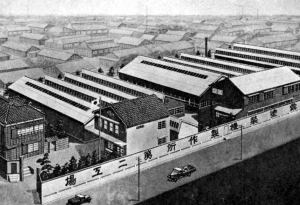 Factories in Shimo-Maruko partially completed in 1940
Factories in Shimo-Maruko partially completed in 1940
With its spray guns and air compressors gaining popularity for their excellent performance, the company increased production to meet market demand. In 1936, it leased a land of about 500 tsubo (1 tsubo being roughly equal to 3.3 square meters) in Shimo-Maruko, Ohta Ward, Tokyo, and built its second factory there. By June 1940, all the production facilities had
been moved to Shimo-Maruko, leaving only the headquarters' sales office in Ebisu where the first factory had been located. Also, as the company was incorporated as a limited partnership firm, its name was changed to Iwata Spray Coating Equipment Seisakusho, Ltd. While the company was enjoying steady growth, however, the shadows of war began to affect its business activities.
The year 1937 saw the promulgation of the Act on Temporary Measures on Imported and Exported Goods, etc., Temporary Fund Adjustment Act, and other laws intended to give priority to the military industry. The National General Mobilization Act, which was officially announced in April 1938, made it difficult for the company to procure materials and secure manpower. With
all kinds of materials now distributed on ration, Iwata Seisakusho experienced a noticeable decline in production from 1939 to 1940 as it used up its stock of materials.
At the end of 1944, employees of the company dug the ground behind Gumyoji Station of the Keihin Kyuko Line and built an underground factory. But, just before they could move the equipment to this makeshift factory, the two air raids that took place on March 9 and April 15 of 1945 burned down the Shimo-Maruko Factory, reducing the manufacturing facilities and the food stocks for employees to ashes. That left them with nothing to do, and the war
ended on August 15, 1945.
Household milling machines and agricultural sprayers
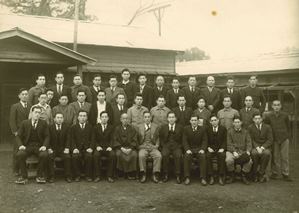
After the end of the war, our country faced unprecedented predicaments such as food shortages. Iwata Seisakusho was no exception. To support the livelihoods of its employees, the company needed to rise from the ashes. On September 27, 1945, a total of 18 employees gathered and embarked on the effort to rebuild the company. They started by collecting scrap materials and constructed a shanty beside the underground factory. Then, they put together machines and tools left over from the fire and repaired them to prepare what could barely be called a production system. For the time being, they decided to manufacture commodities essential to people's everyday lives, instead of air compressors and spray guns. It was around the middle of 1947 when the postwar confusion began to settle down gradually that Iwata Seisakusho started to receive orders for coating equipment in small amounts. The chance for the company to return to its main line of business came earlier than expected.
Development of new spray guns and establishment of a production system for compact air compressors
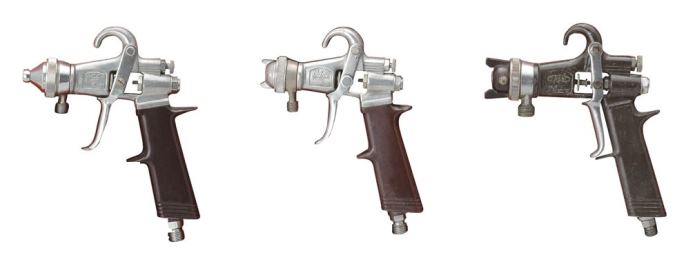
In September 1948, Iwata Seisakusho increased its capital by 302,000 yen, bringing the capital stock to 500,000 yen, and embarked on the construction of a factory and the development of new products. The primary focus was on the overall redesign of spray guns. As the company was making a fresh start after the war, they decided to seek to develop new spray guns with their own technology. They came up with two types of spray gun, type S and type B, and the most remarkable feature of these guns was that they could be operated with a small amount of air. Their exterior designs were also entirely new. The spray gun of type B became popular for its large spray volume and increased work efficiency. The type S spray gun, which featured an easyto-use grip that fit the size of the hand of the average Japanese and a lowoutput air compressor, was well received for its high cost effectiveness.
By contrast, air compressors require manufacturing equipment that is more sophisticated than that used for spray guns, and it was difficult for the company to increase the production of air compressors when they only had war-battered machines and tools. In September 1949, therefore, they decided to get loans from banks and bought used lathes, turret machines, grinders, etc. from major heavy industry firms. Moreover, by borrowing money against these pieces of machinery, the company rapidly expanded and upgraded its production facilities. Up until then, they had stuck to a cautious business approach, doing all business activities with their own cash reserves. So it was a bold decision they made in line with the trend of the times.
Overhaul of the management structure
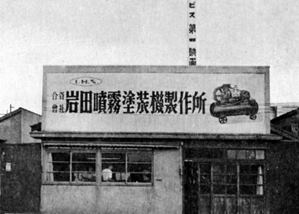
The Japanese economy came back to life because of the special procurement boom that took place after an upheaval broke out in 1950. As the company produced more products, it became necessary to overhaul its overall management structure. What needed to be reviewed urgently was the production facilities. Extensions had been made repeatedly to the factory in Gumyoji to meet the growing demand - almost to the full capacity level.
The company decided to build a new factory in Minami-Tsunashima, Kohoku Ward, Yokohama, and transferred all of the existing factory's facilities to the new site by April 1953. They also decided to rebuild the headquarters in Ebisu, a shanty building, after the new factory was built, and the construction was completed in 1956. In April 1957, Iwata Air Compressor
Mfg. Co., Ltd. was established, inheriting all the business of the limited partnership firm. This new company went public in 1961.
In October 1956, Iwata Air Compressor Mfg. Co., Ltd. formed the IHS Association with 46 subcontractors with which it had particularly close relationships. Members of the company's management attended the regular meeting that was held four times a year to explain the business policy and exchange views in order to promote mutual communication.
Enhancement of product development capabilities
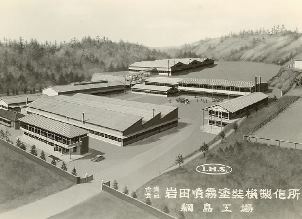
Around 1955 when the Economic White Paper stated that the Japanese economy could no longer be termed postwar, the industrial production of our country started to grow phenomenally. It was the beginning of the era of rapid economic growth. Iwata Air Compressor Mfg. Co., Ltd., which was in the process of shifting gradually toward a modern production system and management structure, was looking to ride this huge wave of the economic boom. The biggest challenge they faced was to develop new products.
In 1954, the company successfully developed rotary automatic coating equipment, which would become the prototype of today's automatic coating equipment, and a flow coater. A flow coater runs down a stream of paint in the form of a thin curtain and coats the workpiece as it is carried under the stream. The development of these products gave Iwata Air Compressor Mfg. Co., Ltd. an opportunity to open up new business fields, helping the company transform itself into an all-around manufacturer dealing with air compressors, coating equipment, and coating facilities. Improvements were also made on the main products, spray guns and air compressors. While manufacturers in the advanced nations in Europe and the U.S.A. were developing spray guns according to rules of thumb, engineers of our company considered it might be possible to develop spray guns with higher performance by theoretically unravelling the mechanism of the gun. They spent four years conducting thorough researches on the relationships of the orifice bore of the paint nozzle, the shape and size of the nozzle tip, and the atomization of paint. Results of these researches revealed that the fineness of atomization was determined by the amount of air passing through the air hole, the central
diameter of the air cap, and the amount of paint sprayed. The spray gun that was developed based on these findings was the Wider 57 (W-57) that was released in 1956. The W-57 became hugely popular for its overwhelming performance and grabbed market share from foreign products that had dominated the market of spray guns for automotive painting.
In the air compressor market, there was growing demand for inexpensive, easy-to-maintain products with high compression efficiency. The company's engineers focused on the development of smaller air compressors supporting higher rotation speeds. After some trial and error, they succeeded in developing C-O-10 and C-O-11 in 1955. The air compressors of the C-O series were compact and supported rotation speeds of up to 900 rotations per minute (compared with 500 rotations per minute typically supported by conventional models). In 1962, the company began to use standardized parts for cylinders, pistons, coupling rods, and other components to enable mass production, which helped drive down the prices of its air compressors.
Further technical innovations were realized, achieving reductions in vibration and noise and improvements in durability and other aspects, as a result of which compact air compressors came to account for more than 50% of the company's overall sales. In addition to making efforts in product development, the company continued to streamline its production lines to cut costs and boost production efficiency. The assembly line method was introduced for air
compressors and other popular products to bring down costs further. Besides the development of new products, another major challenge facing Iwata Air Compressor Mfg. Co., Ltd. was to reinforce its sales network.
Around 1960, the company divided the country into 10 blocs, opened its own sales offices, and staffed these offices with sales engineers in order to increase its sales capabilities.
Construction of Shinyoshida Factory
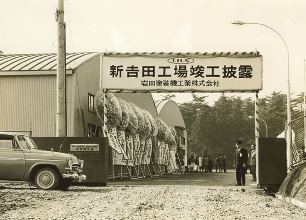
Iwata Air Compressor Mfg. Co., Ltd. managed to meet the growing demand
by streamlining its production system, adding equipment to Tsunashima
Factory, and introducing a day-night double shift system to some of the
processes. Over the period from 1959 to 1968, however, there were several
sharp increases in sales, with the volume of orders ultimately exceeding
production capacity. In anticipation of such a situation, the company had
been considering expanding its factory facilities since 1961. After examining
a number of proposed plans, they decided to construct a new air compressor
factory near the Tsunashima Factory site. A total of 170 employees were
transferred to this new factory, named Shinyoshida Factory (second factory
where the head office is currently located), which was put into operation in
September 1962.